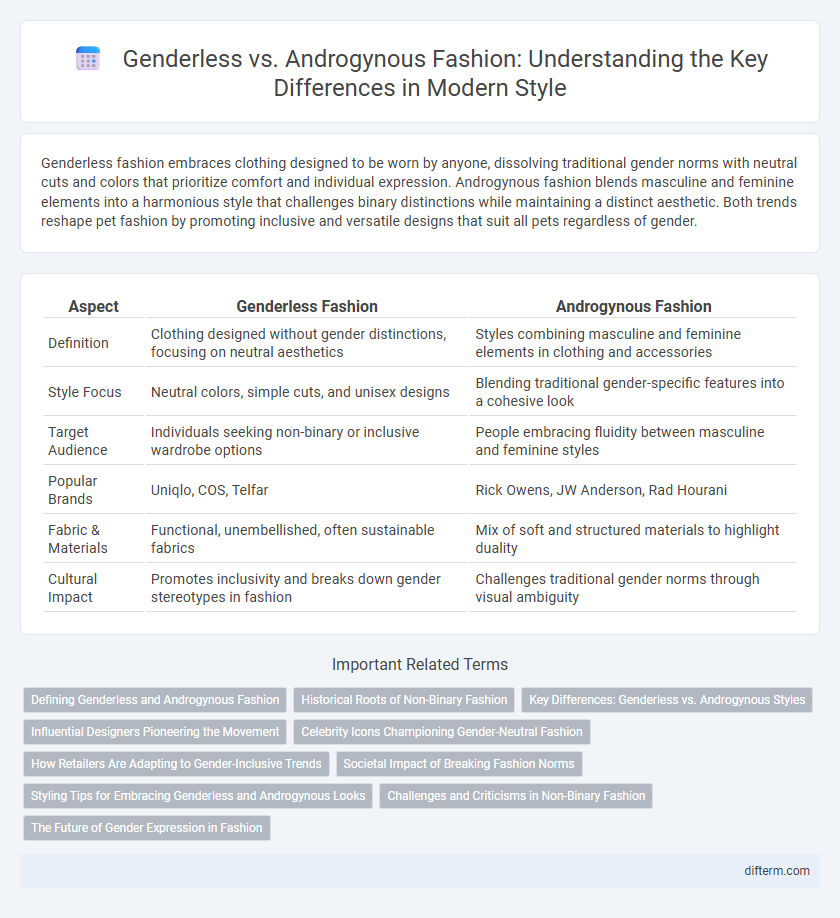Genderless fashion embraces clothing designed to be worn by anyone, dissolving traditional gender norms with neutral cuts and colors that prioritize comfort and individual expression. Androgynous fashion blends masculine and feminine elements into a harmonious style that challenges binary distinctions while maintaining a distinct aesthetic. Both trends reshape pet fashion by promoting inclusive and versatile designs that suit all pets regardless of gender.
Table of Comparison
| Aspect | Genderless Fashion | Androgynous Fashion |
|---|---|---|
| Definition | Clothing designed without gender distinctions, focusing on neutral aesthetics | Styles combining masculine and feminine elements in clothing and accessories |
| Style Focus | Neutral colors, simple cuts, and unisex designs | Blending traditional gender-specific features into a cohesive look |
| Target Audience | Individuals seeking non-binary or inclusive wardrobe options | People embracing fluidity between masculine and feminine styles |
| Popular Brands | Uniqlo, COS, Telfar | Rick Owens, JW Anderson, Rad Hourani |
| Fabric & Materials | Functional, unembellished, often sustainable fabrics | Mix of soft and structured materials to highlight duality |
| Cultural Impact | Promotes inclusivity and breaks down gender stereotypes in fashion | Challenges traditional gender norms through visual ambiguity |
Defining Genderless and Androgynous Fashion
Genderless fashion eliminates traditional gender distinctions by offering clothing that is universally designed, emphasizing comfort, minimalism, and neutral palettes to transcend male and female categories. Androgynous fashion blends masculine and feminine elements within one outfit, often incorporating structured tailoring alongside softer fabrics to create a balanced, fluid aesthetic. Both styles challenge conventional norms but differ in approach: genderless prioritizes neutrality and uniformity, while androgynous highlights a harmonious fusion of gender-specific traits.
Historical Roots of Non-Binary Fashion
Non-binary fashion traces its historical roots to various cultures where clothing transcended rigid gender norms, such as ancient Greek chiton and kimono styles that blurred gender distinctions. The 20th century saw androgynous fashion icons like Marlene Dietrich and David Bowie challenge traditional gendered attire, influencing modern genderless design. Contemporary designers continue to draw inspiration from these historical precedents to create collections that defy binary categories, embracing fluidity and inclusivity in fashion expression.
Key Differences: Genderless vs. Androgynous Styles
Genderless fashion eliminates distinctions between traditional gender categories by offering unisex clothing designed for all bodies without gender-specific styling, emphasizing inclusivity and neutrality. Androgynous fashion blends masculine and feminine elements within a single outfit to create a balanced, ambiguous aesthetic that challenges gender norms through styling choices. While genderless style prioritizes neutrality and universal appeal, androgynous fashion focuses on combining gendered traits to produce visually fluid and versatile looks.
Influential Designers Pioneering the Movement
Influential designers like Rad Hourani, Telfar Clemens, and Harris Reed have significantly shaped the genderless and androgynous fashion movement by challenging traditional gender norms through innovative, unisex collections. Their groundbreaking work blends masculine and feminine aesthetics, promoting inclusivity and fluidity in contemporary fashion. These pioneers persistently expand the boundaries of style, inspiring global brands to embrace diversity and reject binary fashion definitions.
Celebrity Icons Championing Gender-Neutral Fashion
Celebrity icons like Jaden Smith and Harry Styles have revolutionized gender-neutral fashion by embracing fluid styles that defy traditional gender norms. Their bold choices, from skirts to unisex tailoring, challenge the conventional boundaries of menswear and womenswear, inspiring global designers and fans alike. This visible endorsement accelerates the mainstream acceptance of genderless fashion, promoting inclusivity and self-expression.
How Retailers Are Adapting to Gender-Inclusive Trends
Retailers are expanding their collections with gender-neutral clothing lines that feature versatile designs transcending traditional gender norms. Brands are incorporating inclusive sizing, unisex silhouettes, and neutral color palettes to appeal to a broader, diverse customer base. Innovative marketing strategies and flexible store layouts support the growing demand for both genderless and androgynous fashion, fostering a more inclusive shopping experience.
Societal Impact of Breaking Fashion Norms
Genderless and androgynous fashion challenge traditional gender binaries, promoting inclusivity and self-expression across diverse identities. By breaking established fashion norms, these styles foster societal acceptance and reduce stigma around gender nonconformity. This cultural shift encourages brands to diversify offerings, influencing broader social attitudes towards equality and personal freedom.
Styling Tips for Embracing Genderless and Androgynous Looks
To master genderless and androgynous fashion, focus on neutral color palettes such as black, white, gray, and earth tones that transcend traditional gender norms. Incorporate minimalist silhouettes like oversized blazers, straight-leg trousers, and unisex footwear to create balanced and versatile outfits. Accessorize with simple, geometric jewelry and structured bags to enhance the look while maintaining a clean, modern aesthetic.
Challenges and Criticisms in Non-Binary Fashion
Non-binary fashion faces challenges in balancing genderless and androgynous styles, often encountering criticisms for oversimplifying complex identities or reinforcing binary norms. The lack of mainstream representation and limited availability of truly inclusive clothing lines hinders broader acceptance and accessibility. Misinterpretation by brands and consumers can lead to cultural appropriation and tokenism, undermining authentic expression within the non-binary community.
The Future of Gender Expression in Fashion
Emerging trends in fashion increasingly blur traditional gender boundaries, with genderless and androgynous styles redefining self-expression and inclusivity. Designers embrace fluid silhouettes, neutral palettes, and versatile cuts that challenge binary norms, reflecting a cultural shift toward acceptance and diversity. This evolution not only expands consumer choice but also fosters a more dynamic and progressive fashion industry.
genderless vs androgynous fashion Infographic

 difterm.com
difterm.com